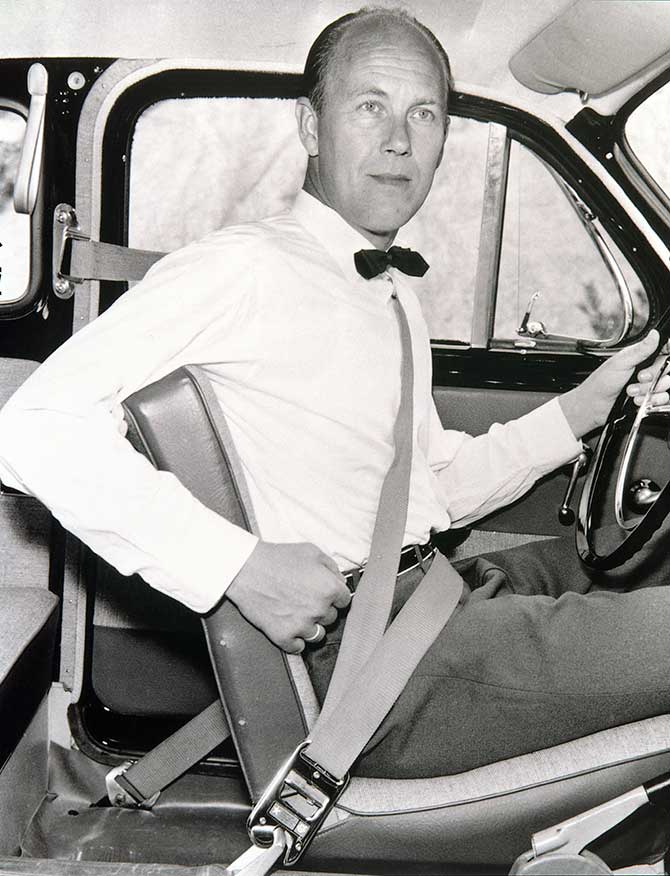Most people only know the basics of car safety—wear your seat belt, never drink and drive, etc. But few are aware of the people whose inventions make them safer, like Nils Bohlin.
The Swedish engineer is credited with inventing the modern three-point seat belt in 1959, a device that has saved millions of lives since then. So let’s take a closer look at how Bohlin’s invention changed car safety forever.

Early Life and Career of Nils Bohlin
In 1920, Bohlin was born in Härnösand, Sweden, and had a background in engineering and physics. He graduated from Harnosand Laroveik with a B.S. in mechanical engineering in 1939.
After graduation, Bohlin began his aviation career as an engineer for Saab AB, a Swedish aerospace and defense company. He later joined Volvo in 1958, where he was tasked with developing new safety features for the company’s vehicles.
Bohlin was only with Volvo for a short time, yet his legacy is one of the most enduring in the automobile industry and the history of traffic safety.
The Beginning of Car Safety
Before Bohlin invented the three-point lap and shoulder seatbelt in 1959, cars were equipped with two-point lap belts. While these belts did keep occupants in their seats during collisions, they weren’t very effective at preventing injuries.
That’s because they put too much pressure on a person’s abdominal area during an accident and wouldn’t keep someone from being thrown out of the vehicle through the window.
Bohlin, who in the 1950s had created ejector seats for Saab fighter jets, became Volvo Car Corporation’s first head safety engineer after being recruited in 1958.
A family member of CEO Gunnar Engelau lost their life in an automobile accident. This tragedy was a driving force behind Volvo’s decision to improve its safety features.
Bohlin recognized that aircraft’s more complicated four-point harnesses wouldn’t work in a car. So when creating the new seat belt, he focused on making it more effective at cushioning the force of the sudden deceleration that occurs after a collision.
Bohlin Changes Everything
In 1958, Bohlin came up with the idea for the three-point seat belt, which made its debut in Volvo vehicles the following year. The new belts connected onto what Bohlin termed “an immovable anchoring point” below the hip, holding the body securely in the case of a collision, and fastened the upper body with straps linked at hip level.
According to Bohlin, “It was only a question of developing a simple, effective solution, and could be put on comfortably with one hand.”
This design was much more effective in preventing injuries and was more comfortable to wear than previous seat belt designs. As a result, Volvo patented the three-point seat belt in 1959, and the company began installing the device as a standard safety feature in its vehicles.
Volvo became the first company to implement Bohlin’s design into its vehicles as standard equipment, saving countless lives. In addition, Volvo’s revolutionary seat belt design was made available to other manufacturers at no cost in the name of safety.
It became mandatory in the United States for all newly manufactured cars in 1968. Engineers have improved the three-point belt since its inception in 1959, but Bohlin’s original concept remains unchanged.
Many other car companies have followed suit by adding this type of seatbelt into their vehicles as well. In addition to his invention of the three-point lap and shoulder seatbelt, Bohlin also developed several other safety devices, such as the Side Impact Protection System for Volvo.
Significance and Impact of the Invention
Bohlin’s three-point seat belt design was a game-changer in the automotive industry, providing a much-needed boost to road safety.
According to estimates, the invention has saved countless lives and prevented countless injuries over the years. For example, the National Highway Traffic Safety Administration (NHTSA) estimates that seat belts save an average of 15,000 lives annually in the United States.
Adopting and popularizing the seat belt as a standard safety feature in vehicles was a slow process, but the efforts of the automobile industry helped it along.
Over time, more and more vehicle manufacturers began to offer seat belts as a standard safety feature in their vehicles, and governments worldwide began to mandate the use of seat belts by drivers and passengers.
Today, seat belts are widely recognized as one of the most important safety features in vehicles and are required by law in many countries.

